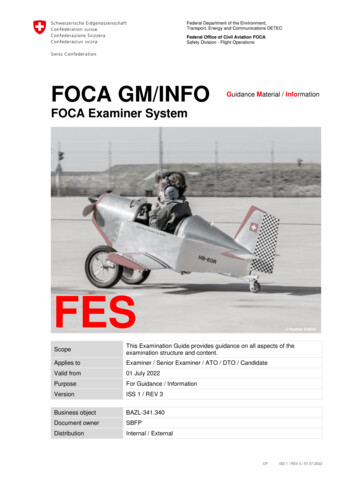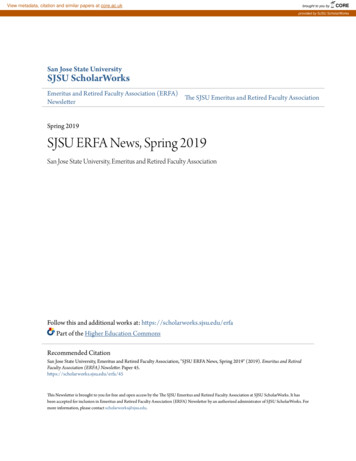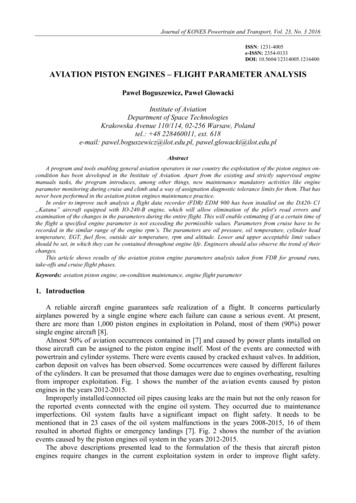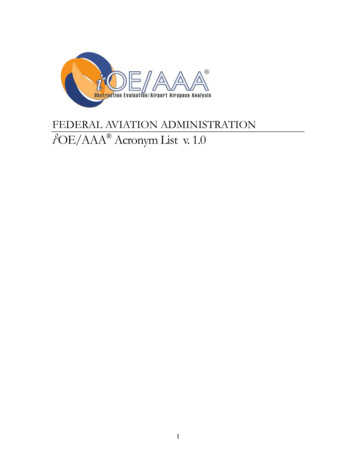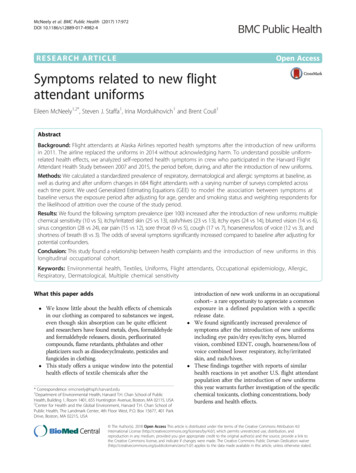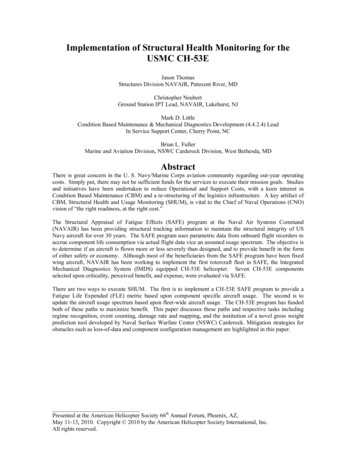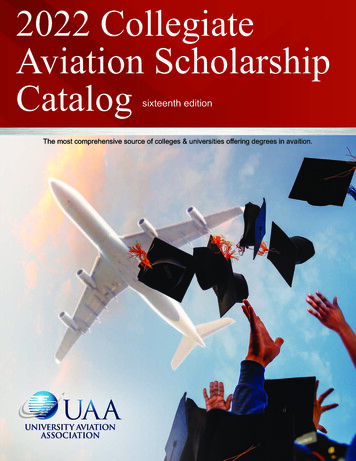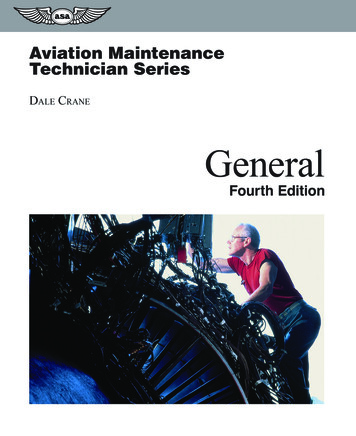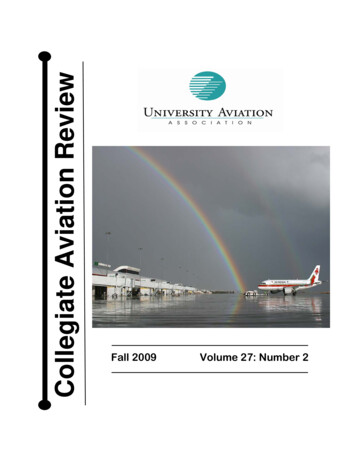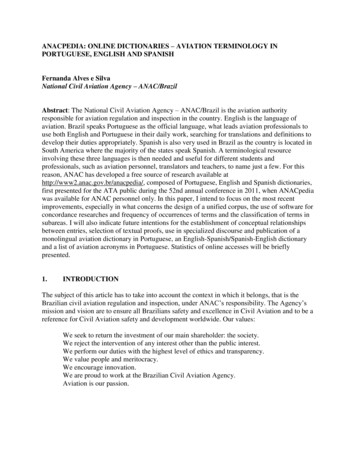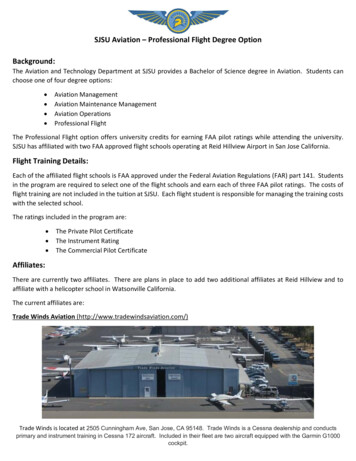
Transcription
SJSU Aviation – Professional Flight Degree OptionBackground:The Aviation and Technology Department at SJSU provides a Bachelor of Science degree in Aviation. Students canchoose one of four degree options: Aviation ManagementAviation Maintenance ManagementAviation OperationsProfessional FlightThe Professional Flight option offers university credits for earning FAA pilot ratings while attending the university.SJSU has affiliated with two FAA approved flight schools operating at Reid Hillview Airport in San Jose California.Flight Training Details:Each of the affiliated flight schools is FAA approved under the Federal Aviation Regulations (FAR) part 141. Studentsin the program are required to select one of the flight schools and earn each of three FAA pilot ratings. The costs offlight training are not included in the tuition at SJSU. Each flight student is responsible for managing the training costswith the selected school.The ratings included in the program are: The Private Pilot CertificateThe Instrument RatingThe Commercial Pilot CertificateAffiliates:There are currently two affiliates. There are plans in place to add two additional affiliates at Reid Hillview and toaffiliate with a helicopter school in Watsonville California.The current affiliates are:Trade Winds Aviation (http://www.tradewindsaviation.com/)Trade Winds is located at 2505 Cunningham Ave, San Jose, CA 95148. Trade Winds is a Cessna dealership and conductsprimary and instrument training in Cessna 172 aircraft. Included in their fleet are two aircraft equipped with the Garmin G1000cockpit.
Squadron 2 (http://www.squadron2.com/)Squadron 2 is located at 2655 Robert Fowler Way, San Jose, CA 95148. Squadron 2 maintains a mixed fleet of Cessna, Piperand Beechcraft aircraft. Primary training can be accomplished in a Cessna 152 training aircraft, or if desired a Cessna 172 orPiper PA‐28‐161.Estimated Training Costs:The tables below detail an estimate for the cost of training for each of the three ratings. Every student is different socosts will vary. We highly recommend an aggressive training schedule flying three to four times per week. This willreduce the likelihood of a student getting “rusty” and having to re‐visit training that has already been completed.Each rating requires mastery of a several skill sets. Instructors at FAA approved schools are required to periodicallyhand‐off their student to the chief pilot for a phase check. The chief pilot will assess the mastery of skills and, ifsuccessful, move the student into the next phase of training. The estimates below are based on average pricing amongthe affiliated (and schools that we are planning to affiliate with in the near future).Private Pilot Certificate:The traditional training time for a Private Pilot Certificate is 40 hours of training of which 20 are dual (with aninstructor) and 20 are solo. FAA approved schools are authorized to release a student for a checkride with 35 hoursof training of which 20 are dual and 15 are solo. That being said, the national average number of training hours isaround 60 to 70 hours. The reason that it gets that high is that most pilot candidates are working regular jobs andtrain once per week with an occasional gap. We are requesting that our students fly 3 times per week and shouldconsider the training hours as part of their school week when they plan their university courses. I hope that most ofour students will be in the 50 hour range (30 dual and 20 solo). Note that there are usually additional hours of groundinstruction before and after each flight. Accordingly, the Private Pilot cost estimate is shown below:PRIVATE PILOT CERTIFICATECost/hrAircraftEst. Rental HoursCostCessna 172SP, Traditional Instruments 153.0040 6,120Cessna 172SP, G1000 Glass cockpit 172.0040 6,880FAA certified Flight Simulator 65.0010 650Cost/hrInstructorAverage Rate Est. Instruction Hours70.00Cost60 4,200On-line Part141 Training material, Headset, E6B calculator 800Written Exam 150Ckeckride 600Traditional 12,520G1000 13,280MiscellaneousEstimated Totals
Instrument Pilot Rating:The Instrument Pilot Rating assumes that the student has gained some flight experience after earning a Private PilotCertificate. Aside from that, an Instrument Rating requires an additional 40 hours of training, some of which can bein a simulator. Some simulator time can be logged in the Instrument Flight course at SJSU, but for budgeting purposes,it is best to assume that all of the training will take place at a flight school. Also note that while the Instrument Ratingrequires 40 hours of actual or simulated flight time, not all of that has to be with a certified instructor. Simulatedinstrument time usually means that the student is flying an airplane while wearing a “hood” that blocks the viewoutside of the windows and allows flight only by use of the aircraft instruments. For planning purposes, it may bebest to assume that all of the hours are logged with an instructor. In addition, there will be ground training timebefore and after each flight, so I have once again doubled the instructor hours. Here is cost/flight hours estimate forthe Instrument Rating:INSTRUMENT PILOT RATINGCost/hrAircraftEst. Rental HoursCostCessna 172SP, Traditional Instruments 153.0030 4,590Cessna 172SP, G1000 Glass cockpit (preferred) 172.0030 5,160FAA certified Flight Simulator 65.0020 1,300Cost/hrInstructorAverage Rate Est. Instruction Hours80.00Cost60 4,800On-line Part 141 Training material, Headset, Charts 400Written Exam 150Ckeckride 600Traditional 11,440G1000 (preferred) 12,410MiscellaneousEstimated TotalsCommercial Pilot Certificate:The Commercial Pilot Certificate requires a few additional steps. There is a requirement to have 250 logged flighthours. This number is reduced to 190 for FAA approved schools. In addition, each student will need to master a fewadditional piloting skills. Accordingly, the training will include:20 hours of training in a non‐complex aircraft such as the Cessna 172 used for the instrument rating10 hours of training in a complex aircraft with retractable landing gear and a constant speed propeller (such as thePiper Arrow)10 hours of cross country flight training (there may be some overlap here with other activities, but for worst case costestimating purposes, assume 10 additional hours of training). The bottom line is that if the student performs well,he/she will have 90 flight hours upon earning the Instrument rating and will receive 40 additional training hourspreparing for the Commercial Certificate. That means that a candidate will need 70 additional flight hours outside ofthe training environment. I have added a line item for this in the estimate below:
COMMERCIAL PILOT CERTIFICATECost/hrAircraftEst. Rental HoursCostCessna 172SP, Traditional Instruments 153.0030 4,590Cessna 172SP, G1000 Glass cockpit 172.0030 5,160Piper Arrow 160.0010 1,600Hours building, depending on required time 153.0070 10,710Cost/hrInstructorAverage Rate Est. Instruction Hours80.00Cost40 3,200On-line Part 141 Training material, Charts 400Written Exam 150Ckeckride 600Traditional 21,250G1000 21,820MiscellaneousEstimated TotalsThe overall training cost estimate total is this:Grand totalTraditionalG1000 45,21047,510NOTESPrice for aircraft may be adjusted for higher fuel costInstructors rates may vary depending on expereince level of the assigned instructorNotes on Total Cost of Flight Training:We have affiliated with multiple flight schools in order to foster competition, and hopefully keep rates in line withother flight schools in California. That means that the total cost will vary with the selection of flight schools, and withthe number of hours each student actually takes to complete each rating. With that in mind, we typically have beentelling students to assume a cost of 45,000 to 46,000 for flight training. If you were to come in under budget, itwould be possible for the student to continue training for things such as a multi‐engine rating or possibly to continuetraining for a flight instructor rating.Restricted Airline Transport Pilot Rating:Earning the Commercial Pilot Certificate is a starting point for an aspiring airline pilot. The eventual goal for most ofour students is to be an airline pilot. Most major airlines require two key items to be considered employable: AnAirline Transport Pilot Rating (ATP), and a Bachelor’s Degree from a university. SJSU provides the required Bachelorof Science degree. In the piloting arena, aspiring pilots must accrue 1500 flight hours to be eligible for the ATP rating.
The FAA has provided a Restricted ATP rating for pilots who have graduated from key universities offering Aviationprograms. SJSU has applied to be on that authorized list as of July 2016. We expect to have that authorization by theend of the 2016 school year.This program allows airlines to hire a pilot with a Restricted ATP rating (RATP). That RATP pilot can serve at a co‐pilot.The restrictions are lifted when the pilot accrues 1500 flight hours.Making the Leap from Commercial Pilot to Airline Transport Pilot:Commercial pilots can fly for hire, but an Airline Transport Pilot rating is required to fly for a scheduled airline.Graduates from programs like SJSU’s Professional Flight program will need to build a substantial amount of experienceto apply for an ATP rating. That can be done through by a number of methods:Become a Flight Instructor – many pilots have built their flight time by first obtaining a Certified Flight Instructorrating. They can then instruct primary students. While doing that, the pilot builds hours and is able to earn money.This is the most common method for civilian pilots to build hours. There are additional cost associated with obtaininga flight instructor rating.Get a Job as a Pilot – A commercial pilot can get a job doing many things flying in small aircraft. The jobs include airphoto operations, traffic watch, pipeline patrol, and flying corporate aircraft. All of these roles are for hire so the pilotis earning in this career phase rather than spending.Fly Recreationally – Many pilots travel in small aircraft with the primary intent being to build flight time. Most pilotswho have a position as a flight instructor or as a corporate pilot also increase their logged flight time by taking trips ina rental aircraft.Implementation – Since we are asking students to pursue an aggressive training pace, we should point out that thereis a significant amount of time involved in flight training. A typical lesson is a one hour flight. Instructors expect tospend time prior to the flight to brief the lesson and set expectations to define successful mastery of a skill set. Theflight instructors also need to spend time with their student after each flight to provide an after‐action session. Thiswill establish the required study material that the student should accomplish prior to the next lesson. Accordingly, atypical lesson will take up to three hours plus travel time from main campus to the flight schools at Reid Hillview. If astudent flies for three to four lessons per week, it is a good idea to reduce the class load for university coursework.The faculty recommends that a student take approximately 12 unit hours during semester in which a rating is beingstarted.It is noteworthy that while we recommend aggressive training, students self‐pace their flight training. If a studentsigns up for one of the flight classes (AVIA 3, AVIA 63 or AVIA 113), we anticipate that many students will not completethe rating by the end of the school semester. In these cases, a grade of Incomplete (“I”) will be assigned. Universitypolicy allows one year for the student to complete the required coursework. If a student needs more time, he/shecan continue training in the winter break or during the summer.Revision 1 (July 2016)
SJSU has affiliated with two FAA approved flight schools operating at Reid Hillview Airport in San Jose California. Flight Training Details: . it is best to assume that all of the training will take place at a flight school. Also note that while the Instrument Rating requires 40 hours of actual or simulated flight time, not all of that has to .
